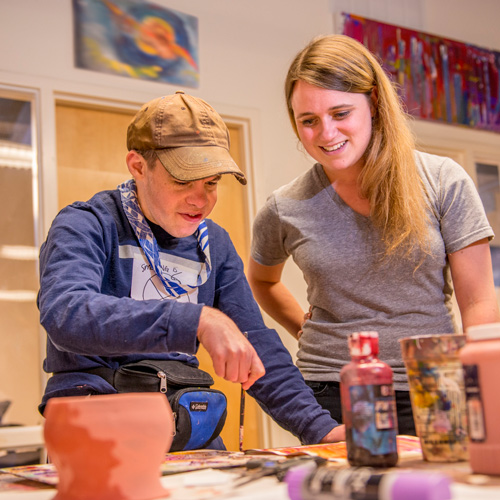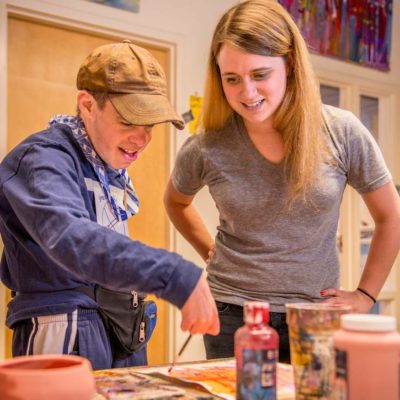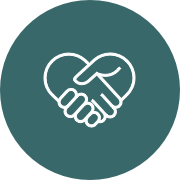
Person-Centered at ITKC!
JP is very verbal. He talks all the time. But because he uses a language that is very much his own, he struggled to communicate. Providers who attempted to teach JP to communicate usually frustrated him, because he struggled to learn their language.
When he came to Imagine That!, JP’s staff found a way to communicate with him. They learned his language.
“Communication, and being understood, is extremely important to JP,” said Program Director Amy Norman. “He can become frustrated when he’s not understood. Someone who doesn’t know JP well might not understand JP, or his version of sign language. As JP appeared to become more frustrated, the staff at the studio agreed there was a need to collect what we’d learned through interactions with him and use it as a tool.”
When JP was a child, his grandmother wrote down words on pieces of paper, which he’d collect and show others. His mother began making paper bracelets that JP would wear on his wrist, so that some basic needs could be communicated. But when JP attempted any more complicated interactions, he’d roll out jumbles of words that sounded to an untrained ear like gibberish.
The staff at Imagine That! discovered that it wasn’t gibberish — it was his language. His words were consistent — what he’d call something, what he’d ask for, was not something his staff could recognize, but it was always the same. So the staff started a Learning Log to document what JP was saying and match up his words and phrases with what he wanted. And little by little, they learned his language.

“Each day the staff member working with him would add to the Learning Log something they discovered about JP’s communication — when JP is doing this, we think it means this, and we should do this for him,” Norman said. “Everyone began to realize how important JP’s style of communication is to him, and was a great tool to build a relationship.”
JP is an example of the Person-Centered Thinking training that staff at RHD Missouri in Kansas City underwent to better serve their clients. All RHD programs emphasize the person in the service, respecting and responding to an individual’s needs.
“Person-Centered Thinking goes along with the Values at RHD,” Norman said. “It starts with where a person is, and what their strengths are. We don’t see people as having a disability, we see them as people with abilities. We look at what’s working and what’s not, and we can better determine what supports a person wants and needs — and what skills are needed from the staff to support that person.
“Person-Centered Thinking is more of a mentality than a tangible, although when we experience issues we’ll pull out a tool and work through them. But it’s something we’ve incorporated into the environment as a way that we deliver services and supports.”
A client named Brittany communicated one thing verbally but often gave off an entirely different emotion through nonverbal communications like body language. The staff identified possible triggers, successful and unsuccessful responses, and identified 18 behaviors to which they learned to respond. Removing some of the uncertainty in the staff’s responses allowed Brittany to trust and genuinely bond with her staff, who worked to create an atmosphere where she can be happy.
“We encourage every employee to share their findings with the larger team, which strengthens our support systems,” Norman said. “The staff has bought in and got excited about it. Everybody is committed to supporting people in the best way possible. It is that Value of decentralization of authority, in that everybody has a voice in how we operate and the staff is highly involved in deciding the best methods of support.
“We don’t want to operate in a crisis culture. This entire organization is a place where every day we just think: What can we do better?”


